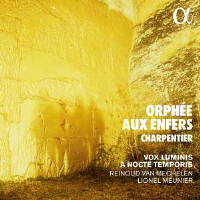Reviewer: William
J.Gatens
Marc-Antoine Charpentier
(1643-1704) is best known for his sacred music, much of it written in the
1680s for the private chapel of the Duchess of Guise in Paris. These two
pieces based on the Orpheus legend are examples of secular music produced
for her musical establishment. The earlier piece, written in 1684, is the
chamber cantata Orpheus Descending into Hell (H 471) for three voices,
recorder, transverse flute, two violins, and continuo. It presents a
vignette from the legend. Orpheus journeys through the underworld singing a
lament for Eurydice. He encounters Tantalus and Ixion, who feel their
infernal tortures mitigated by the sound of his song. As Vincent Borel
points out in his notes, Charpentier’s work displays the influence of his
studies with Giacomo Carissimi in Rome and his exposure to Italian dramatic
composition at that time. In contrast with the formal
recitative-air-recitative-air structure typical of the French chamber
cantata of the late 17th and early 18th Centuries, Charpentier delves into
the dramatic character of the brief episode. The boundaries between
recitative and lyrical idioms are not as sharply drawn as we might expect,
so that recitatives take on the character of declamatory arioso comparable
to liturgical settings of the Tenebrae Lessons by Charpentier and others,
while the lyrical idiom seems less bound to formulaic structures. This
produces a fluid continuity as the music passes from one to the other.
The other piece, Orpheus’s Descent into Hell (H 488), first
performed in 1687 at the Guise mansion in Paris, is a miniature opera. Two
of its three acts survive. It has a larger instrumental ensemble and cast of
characters than H 471, including a chorus of nymphs and shepherds in Act I
and a chorus of shades and furies in Act II. Act I begins with arcadian
revels in honor of the marriage of Orpheus to Eurydice until she is bitten
by the serpent and dies. Orpheus enters as she is expiring and is
devastated. He wants to take his own life, but Apollo persuades him to seek
Eurydice in the underworld. Act II takes place in the underworld. As in H
471, Orpheus encounters the shades of Ixion and Tantalus, here augmented by
the shade of Tityus to form a mellifluous male-voice trio. As in the earlier
cantata, they derive comfort from Orpheus’s song. At length Orpheus comes
into the presence of Pluto, who threatens him. Orpheus pleads his case,
Proserpina is touched, and eventually Pluto relents, allowing Orpheus and
Eurydice to return to the living on the condition that Orpheus not turn to
look on her during the journey. The act concludes with serene choruses of
shades and furies and a gentle instrumental symphony.
Notations in the manuscript indicate that the piece was staged.
From 1672 until he died, Jean-Baptiste Lully was director of the Academie
Royale de Musique, and that gave him complete control of opera in Paris.
Operatic productions under any other auspices were banned. Perhaps it was
only because the Duchess of Guise was a member of the royal family and was
presenting Orpheus’s Descent
into Hell
at her private residence that
Lully was unable to quash the production. That was the year that Lully died.
Charpentier wrote several operas afterwards, most notably Medée
(1693). It was not a popular success at the time, but it is now regarded as
one of the outstanding works of French lyric tragedy. At least five of his
operas are lost.
In this performance both Lionel Meunier and Reinoud van Mechelen
are credited as musical directors. Both also perform as singers: Van
Mechelen (haute contre) as Orpheus in both works and Meunier (baritone) as
Tantalus in H 471 and Apollo and Tityus in H 488. The performance standard
is first rate. The singers have light but substantial voices as befits this
repertory. Both singers and players
perform this music as if it is
their native language. The recorded sound is warm and clear, but as I find
with so many recent recordings of early music, it is excessively close.
Sometimes I can hear the breathing of the director. The lack of aural space
can be stifling, analogous to viewing a large mural while constrained
to stand no more than 20
inches from the wall. Levels are high, almost to the point of distortion.
Turning down the playback volume helps, but the sound still seems too close.
It is hard to find fault with the performance itself. My one
complaint is that the harpsichord continuo is prominent to the point of
distraction. Some of this may be from the too-close recording, but the
realization itself seems too busy to me, though I have heard worse. Continuo
should supply an unobtrusive support to the solo voices and instruments
without attracting undue attention to itself. It is worth noting that organ
and theorbo also appear as continuo harmony instruments, and the contrasts
in color and character are highly effective.
In these two works Charpentier displays himself as a master of
dramatic composition and pacing. In this recording the pluses far outweigh
the minuses. I commend it to anyone wishing to make the acquaintance of
these two remarkable works. As for earlier recordings of H 488, Gil French
had good things to say about the one directed by William Christie (Erato;
M/J 1997), and John Barker had compliments for recordings by Paul O’Dette
and Stephen Stubbs (CPO 777 876; S/O 2014) and by Sebastien Daucé (HM
902247; N/D 2017).
Fermer la fenêtre/Close window
|




